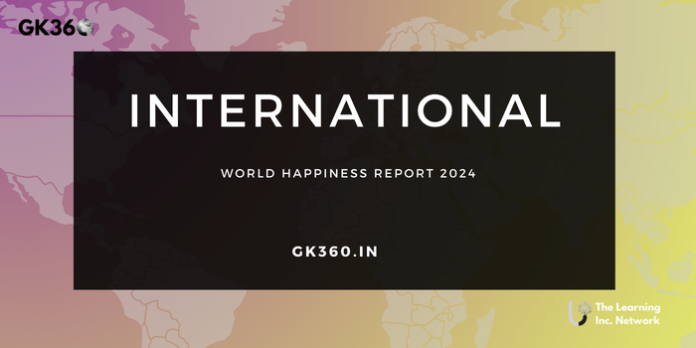World Happiness Report 2024: Why Finland Remains the Happiest Country on Earth
Introduction
For the eighth consecutive year, Finland has secured its place at the top of the World Happiness Report 2024, maintaining its status as the happiest country in the world. Published by the Wellbeing Research Centre at the University of Oxford, in collaboration with Gallup and the United Nations Sustainable Development Solutions Network, the report evaluates global well-being based on how citizens perceive their quality of life.
While Finland continues to excel in emotional well-being, social trust, and governance, the report also draws attention to significant declines in happiness in countries like the United States and United Kingdom. In a world grappling with geopolitical tension and economic uncertainty, the findings underscore the importance of investing in emotional, social, and institutional well-being.
Table of Contents
- What Is the World Happiness Report?
- Finland Tops the Happiness Rankings Again in 2024
- How Happiness Is Measured: Key Metrics Explained
- The Role of Social Trust in National Happiness
- U.S. and UK Happiness Rankings Hit Record Lows
- Why Geopolitical Threats Haven’t Affected Finland’s Joy
- Happiness Inequality: A Growing Concern
- Lessons from the Nordic Model
- FAQs: Global Happiness and the 2024 Report
- Conclusion: What the World Can Learn from Finland
What Is the World Happiness Report?
The World Happiness Report is an annual survey-based analysis that ranks countries based on the subjective well-being of their citizens. First published in 2012, it has become a global benchmark for understanding happiness from both social and policy perspectives.
Purpose of the Report:
- To measure citizens’ satisfaction with their lives.
- To analyze how economic and social indicators affect well-being.
- To help governments and institutions understand what drives sustainable happiness.
Methodology:
- Survey responses from over 140 countries.
- People rate their lives on a scale from 0 to 10.
- Data averaged over three years (2021–2023) to ensure reliability.
The rankings are not just about economic wealth but consider emotional, social, and institutional factors that influence happiness.
Finland Tops the Happiness Rankings Again in 2024
For the eighth year in a row, Finland leads the global happiness rankings, showcasing remarkable consistency in maintaining high levels of life satisfaction and emotional well-being.
Why Finland Ranks So High:
- Strong Social Safety Nets: Access to free education, universal healthcare, and generous parental leave.
- High Public Trust: Citizens trust their government, police, and each other.
- Personal Freedoms: High levels of autonomy and freedom of expression.
- Low Corruption: Institutions are transparent and efficient.
- Balanced Lifestyle: A strong emphasis on work-life balance and time in nature.
Alongside Finland, other Nordic countries like Denmark, Iceland, Sweden, and the Netherlands round out the top five, reinforcing the success of the Nordic model in cultivating national happiness.
How Happiness Is Measured: Key Metrics Explained
The World Happiness Report bases its rankings on six core indicators that reflect both material and emotional well-being:
| Indicator | Description |
| GDP per Capita | Economic prosperity that supports basic needs and life satisfaction. |
| Healthy Life Expectancy | The number of years people live in good health. |
| Social Support | Having dependable social relationships and support networks. |
| Freedom to Make Life Choices | Autonomy in personal decisions increases happiness. |
| Generosity | Helping others, donating, and volunteering positively impact well-being. |
| Perception of Corruption | Lower perceived corruption equals higher public trust. |
Each of these metrics correlates strongly with how people rate their lives, offering a multidimensional view of happiness.
The Role of Social Trust in National Happiness
One of the standout insights from the 2024 report is the pivotal role of social trust in determining happiness levels. Citizens who trust their neighbors, institutions, and leaders report significantly higher life satisfaction.
In Finland, surveys show that most people believe a stranger would return a lost wallet—an indicator of deep-rooted interpersonal trust. This cultural value fosters community resilience, especially during times of global uncertainty.
U.S. and UK Happiness Rankings Hit Record Lows
While Nordic nations continue to thrive, both the United States and United Kingdom have experienced historic dips in happiness:
United States (Rank: 24th)
- Fell from 13th in 2016 to 24th in 2024.
- Reasons for the drop:
- Increasing income inequality.
- Political polarization and social division.
- Rising healthcare and housing costs.
- Declining institutional trust.
United Kingdom (Lowest since 2017)
- Economic uncertainty post-pandemic.
- Public service dissatisfaction.
- Widening gap between social classes.
These declines emphasize that economic prosperity alone doesn’t guarantee happiness—social cohesion and trust are equally essential.
Why Geopolitical Threats Haven’t Affected Finland’s Joy
Despite regional risks—such as its proximity to Russia, cyber threats, and hybrid warfare tactics—Finland’s happiness score remains robust.
What Shields Finland’s Well-Being:
- Crisis-ready institutions.
- Strong cybersecurity infrastructure.
- Emphasis on mental health support.
- A resilient, well-informed public.
This resilience shows that well-structured societies can buffer external threats and maintain internal harmony.
Happiness Inequality: A Growing Concern
One of the most alarming findings in the 2024 report is the rise in happiness inequality—the widening gap between the most and least satisfied individuals.
Happiness inequality has increased by 25% over the last two decades, even in high-income countries.
Why It Matters:
- Inequality erodes social trust.
- Leads to civic unrest and mental health issues.
- Weakens overall societal stability.
Governments are now urged to invest not just in GDP growth but in policies that uplift underserved populations.
Lessons from the Nordic Model
Countries aiming to improve their global happiness rankings can look to Nordic nations for actionable insights:
What Sets Them Apart:
- Transparent and accountable governance.
- Investment in universal healthcare and education.
- High gender equality and family support.
- Cultural emphasis on community, fairness, and trust.
Rather than focusing solely on economic indicators, these nations prioritize quality of life and inclusive growth.
FAQs: Global Happiness and the 2024 Report
What is the World Happiness Report?
It’s an annual UN-backed study that ranks countries based on citizen well-being, using factors like income, health, freedom, and trust.
Why does Finland rank so high in happiness?
Finland excels in social support, freedom of choice, low corruption, and public trust—all critical drivers of well-being.
What caused the U.S. to fall in the rankings?
Rising inequality, polarization, and declining trust in institutions contributed to the drop.
How is happiness measured in the report?
Via global surveys where citizens rate their lives from 0 to 10, averaged over three years, and assessed against six key indicators.
Can countries improve their happiness ranking?
Yes. Through investments in social infrastructure, mental health, trust-building, and inclusive policies.
Conclusion: What the World Can Learn from Finland
The World Happiness Report 2024 is far more than just a list of rankings—it’s a comprehensive guide to understanding human well-being in a rapidly changing world. It reveals that happiness is not confined to economic success or high GDP alone. Instead, it is deeply rooted in how societies operate, the strength of social connections, the transparency of institutions, and the presence of a shared sense of purpose and fairness.
At the heart of Finland’s continued dominance in the happiness rankings lies a cultural and institutional blueprint that other nations can learn from. Finland’s social fabric is woven with mutual respect, inclusivity, and trust—three pillars that create a stable and fulfilling life for its citizens. Rather than aiming solely for material gains, Finland invests in the quality of relationships—between individuals, communities, and the state.
Key Takeaways Table
| Aspect | Details |
| Report Authority | Published by Oxford Wellbeing Research Centre in collaboration with Gallup and UN SDSN |
| Finland’s Rank | Ranked #1 for the 8th year in a row |
| Top Factors for Happiness | Social safety, public trust, autonomy, low corruption, work-life balance |
| Measurement Method | Based on surveys from 140+ countries rating life from 0–10 (2021–2023 average) |
| Key Indicators | GDP, life expectancy, social support, freedom, generosity, corruption perception |
| U.S. & UK Rankings | Significant declines in national happiness levels |
| Global Relevance | Underscores emotional and institutional well-being in unstable times |





